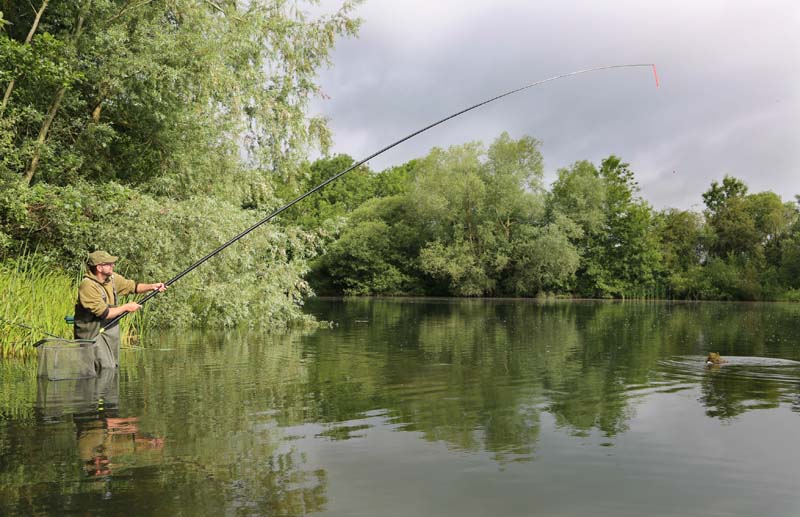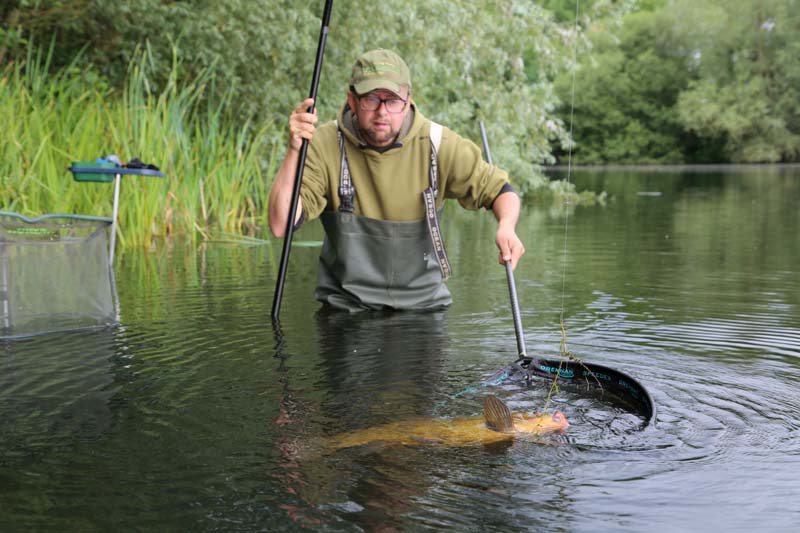Try the pole for specimen tench!
Summer tench are worlds removed from those of spring. Somewhere in the intervening months they wise-up, and from being gullible mug fish they morph into creatures of almost streetwise intelligence.
Popping bubbles around a float no longer guarantee a bite, my beloved lift method fails to deliver, and while my waggler may sway, rarely will it dip!
So, what has happened? I can only assume a pre-spawning feeding frenzy causes the tench to slip up, whereas now, with a full belly and a well stocked natural larder, they can graze their way through the long summer days.
Eating at a slower pace allows each prospective mouthful to be investigated and spat out quickly if anything is amiss – or they can ignore it completely.
So when I fancied another morning in the company of the doctor fish I knew to leave the rod holdall behind.
Raindrops on the truck’s windscreen told me it had been a damp night, and thick cloud cover on the way to the pit indicated that rain wasn’t far away.
There would be no sunrise this morning, always a bonus on the fishing front. Little wonder, then, that I arrived at my destination full of confidence.
The warm breeze I felt walking to the swim was an added bonus, as was a fish flopping out on the surface, sending ripples towards my bank.
I wasn’t the only one up early, as a heron was already stalking a frog in the margins. This is the very best time to be out in the countryside, observing nature before the arrival of bird watchers and walkers.
Pinpoint accuracy
Now, pole fishing outside of a match is rarely seen on a large natural venue, but that doesn’t mean it’s only useful for commercial carp. The equipment is robust enough to tame the biggest tench, and if you can find them it guarantees plenty of hook-ups.
A rod and reel can never supply the pinpoint accuracy afforded by a pole, which is why I was putting my faith in one, no matter how out of place it looked on a large gravel pit. My plan was to don a pair of chest waders and stand quietly at the beginning of the marginal slope, fishing 6m of Drennan Margin Carp pole above a hole in the weed.
My orange carp bungee elastic with a nominal rating of 25 – impossibly powerful – would counter any thunderous tail slaps, as would 8lb Supplex fished direct through to a size 16 Super Specialist barbel hook. Without a hooklength there were no weak spots, and while I might have appeared to be a match angler my focus was solely on big fish.
Complete confidence
To fish effectively with the pole everything needs to be to hand, so I really appreciated the tray by my side that was supporting bait and terminal tackle.
A plummet was high on my list, as nothing can check the depth with greater precision.
I slowly pushed my AS float up the line until the hook kissed the gravel bottom. I needed to get this adjustment spot-on, as it would make the difference between catching and a blank. Only when I was certain everything was perfect did I mark the depth on the pole with Tipp-Ex and pinch a small No8 shot on beneath the float to stop it slipping during the fight.
With complete confidence in both my set-up and where I was going to put it I could now feed my chosen spot, once again with supreme accuracy.
The catapults stayed in the rucksack and instead I attached a pole cup to a spare top-2 section and shipped out directly above the hole in the weed
My red and white maggot feed was tipped in and landed on the bottom in an area smaller than a dinner plate. I then switched back to the section carrying the float and attached four grubs to the hook, one of these being a Drennan artificial maggot whose buoyancy would critically balance the metalwork and shoot the hook into the back of a tench’s throat if it were sucked in. Then, with minimal disturbance, I placed the rig exactly over the spot where the free maggots had gone in.
I find that standing in the lake while I fish heightens the connection I feel with that environment. I adore the sound of water lapping against my waders only a short distance away from my quarry. In this case it was 6m of pole, no trouble at all to hold.
I watched the surface around the float as much as I did the tip, hopeful of a sign. It duly came within 10 minutes and a smile spread across my face as a stream of pinprick bubbles fizzed and popped. By watching their direction I could tell where the tench’s head was, and it was making a beeline for the maggots.
In May this would have meant a certain bite, no matter what rig I used, but not in summer. Then, hours of line bites signalled by a swaying or dipping waggler can be acutely frustrating.
If I’d got it right a bite was imminent. Another flurry of bubbles erupted, some clinging to the float... but not for long!
The orange tip sank slowly and deliberately, and I lifted the pole in response. Orange elastic poured from its tip and I felt a satisfying head shake as the hook pulled home. Then the fun began.
Believe it or not, a pole is no hindrance to landing big fish in weed, as it affords leverage from above that no rod can match. That initial charge was the moment of truth, but as the elastic gradually applied more pressure I drew the tench back to me then simply followed it around as though it were a dog on a lead until all its energy was spent.
With the fish safely unhooked, admired and released I fed again, and the tench obliged all morning. Wised-up as they were, they had no answer to the pole and every set of bubbles was converted to a hooked fish. Great fun and highly effective – so if tench are teasing you this summer try the pole and you’ll be the one laughing!






